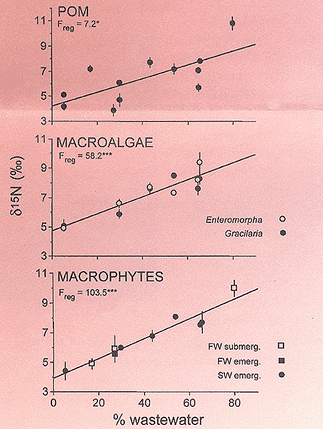
|
Archives:
Summer/Fall 2001 Table
of Contents In science, it is more often the norm than the exception that what works in one location does not always work in another. But for Marci Cole, a graduate student in the Boston University Marine Program (BUMP), the science gods must be smiling. Cole’s WHOI Sea Grant-supported research tracks land-derived wastewater nitrogen in groundwater and aquatic plants in Waquoit Bay, a saltwater embayment on Cape Cod. Cole has been delighted to find that the model also works in three estuaries (Great and Green Ponds in Falmouth, and Mashpee River), two freshwater ponds (Ashumet and Coonamessett Ponds in Falmouth), and one salt pond (Miacomet Pond on Nantucket). And what’s more: it works from season to season. "This information–and the method– should be useful for managers," says Cole. "It’s easy, relatively cheap, and transferable." Cole’s work is based on the so-called nitrogen loading model, or NLM, developed by her advisor, Ivan Valiela, a BUMP professor of biology, and Jim McClelland, a 1998 graduate of BUMP now a postdoctoral researcher at the Marine Biological Laboratory, where BUMP is based. The NLM, funded in part by WHOI Sea Grant, estimates the percentage of wastewater nitrogen in an estuary that comes from groundwater. It can also estimate the nitrogen load from atmospheric deposition and fertilizer. Those calculations are based in part on calculations of land use data, gathered via aerial photography (for example, houses, open space, wooded areas, farms, cranberry bogs, golf courses, and so on), and GIS data. Of the three sources of nitrogen, the signature from wastewater nitrogen–d15N–is the highest in groundwater. That makes it easy to spot, explains Cole. That’s where Cole’s work comes in. Hard work. She has spent countless hours in all kinds of weather collecting groundwater with an instrument called a piezometer, driving it into the ground every 50 meters around each of her six sites for each of three seasons. Cole’s reward for hard physical labor: samples that provide actual nitrogen concentrations for groundwater (measured in micromolar, or ÁM), as well as the d15N signature. While in the field, Cole collects samples of particulate organic matter (POM) and producers: algae at marine sites and macrophytes at freshwater sites, and marsh vegetation at all sites. These samples are collected near the shore or from a boat at 10 locations within each estuary. "We collect a handful of whatever is most abundant from each site. We try for the same thing in each estuary, for example Spartina in the saltwater sites and cattails in the freshwater sites," says Cole. The samples are then taken back to the lab where they are rinsed, dried, ground up, and sent off for analysis. That analysis provides in a stable isotopic signature (d15N) for each producer. Each producer is then assigned a single value per season, per estuary. Cole’s results indicate that macrophytes (Spartina, Typha, submergent plants) are the best indicators of wastewater nitrogen, though macroalgae (Enteromorpha, Gracilaria) are "not bad." POM, says Cole, "was not very reliable." Based on those results, and the fact that no seasonal pattern emerged, Cole believes that collecting producers–perhaps only macrophytes–in summer would suffice. Recalling her days spent trudging along shorelines in boots and sampling from a small boat, Cole thinks that is a real plus. "That is good for people, say coastal managers, who may be interested in using this method: you don’t have to go out in a boat or even get your feet wet."
With the signatures in hand, Cole then compared her results to modeled wastewater nitrogen load for each estuary (from the NLM). Cole’s results show that a relationship exists between the isotopic signal of groundwater and producers, and the wastewater nitrogen load value derived from the model (see graph). This relationship can be used to predict what percentage of nitrogen–of all the nitrogen coming into an estuary–is coming from wastewater via groundwater," explains Cole. "A value of 0—20 percent would be considered a good scenario, and 60—80 percent would represent the high end." To get a sense of the range involved, Sage Lot Pond (a salt pond located just east of Waquoit Bay) is 8 percent; Miacomet Pond on Nantucket is around 30 percent; Great and Green Ponds (salt ponds west of Waquoit Bay) and Quashnet and Child’s Rivers (freshwater inputs to Waquoit Bay) are between 40 and 65 percent; and Ashumet Pond (a fresh pond northwest of Waquoit Bay) is between 81—82 percent. In addition to the analyses conducted on the producers, the groundwater samples are analyzed for nitrate, ammonium, total dissolved nitrogen, and stable isotopes for nitrate and ammonium. For freshwater sites, phosphate is measured as well. For someone who came to graduate school hoping to work on estuarine sediment cores, Cole has not spent much time looking at sediment, other than the occasional groundwater sample containing fine grains ("it looked like a chocolate milkshake and took three hours to filter," she says). But her results have made her happy with few regrets. "I like the idea that my work has management implications," she says. "It makes me feel good about what I do;knowing that it’s useful in some way. But I won’t miss the briars, poison ivy, and ticks." |
